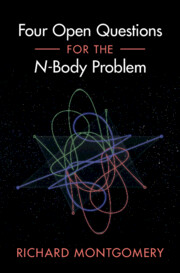Refine listing
Actions for selected content:
17002 results
Part Two - The Questions
-
- Book:
- Four Open Questions for the <i>N</i>-Body Problem
- Published online:
- 12 December 2024
- Print publication:
- 19 December 2024, pp 73-74
-
- Chapter
- Export citation
Appendix A - Geometric Mechanics
-
- Book:
- Four Open Questions for the <i>N</i>-Body Problem
- Published online:
- 12 December 2024
- Print publication:
- 19 December 2024, pp 217-227
-
- Chapter
- Export citation
Appendix D - The Orthogonal Group and Its Lie Algebra
-
- Book:
- Four Open Questions for the <i>N</i>-Body Problem
- Published online:
- 12 December 2024
- Print publication:
- 19 December 2024, pp 262-263
-
- Chapter
- Export citation
Appendix B - Reduction and Poisson Brackets
-
- Book:
- Four Open Questions for the <i>N</i>-Body Problem
- Published online:
- 12 December 2024
- Print publication:
- 19 December 2024, pp 228-241
-
- Chapter
- Export citation

Four Open Questions for the N-Body Problem
-
- Published online:
- 12 December 2024
- Print publication:
- 19 December 2024
Part III - Conclusions
-
- Book:
- Power Laws in Astrophysics
- Published online:
- 05 December 2024
- Print publication:
- 12 December 2024, pp 205-206
-
- Chapter
- Export citation
Dedication
-
- Book:
- Power Laws in Astrophysics
- Published online:
- 05 December 2024
- Print publication:
- 12 December 2024, pp v-vi
-
- Chapter
- Export citation
9 - Coronal Mass Ejections
- from Part II - Astrophysical SOC Phenomena
-
- Book:
- Power Laws in Astrophysics
- Published online:
- 05 December 2024
- Print publication:
- 12 December 2024, pp 126-132
-
- Chapter
- Export citation
1 - Fundamentals
- from Part I - Fundamentals of SOC
-
- Book:
- Power Laws in Astrophysics
- Published online:
- 05 December 2024
- Print publication:
- 12 December 2024, pp 3-24
-
- Chapter
- Export citation
Frontmatter
-
- Book:
- Power Laws in Astrophysics
- Published online:
- 05 December 2024
- Print publication:
- 12 December 2024, pp i-iv
-
- Chapter
- Export citation
Preface
-
- Book:
- Power Laws in Astrophysics
- Published online:
- 05 December 2024
- Print publication:
- 12 December 2024, pp xvii-xviii
-
- Chapter
- Export citation
13 - Planetary Systems
- from Part II - Astrophysical SOC Phenomena
-
- Book:
- Power Laws in Astrophysics
- Published online:
- 05 December 2024
- Print publication:
- 12 December 2024, pp 159-167
-
- Chapter
- Export citation
Abbreviations
-
- Book:
- Power Laws in Astrophysics
- Published online:
- 05 December 2024
- Print publication:
- 12 December 2024, pp xix-xxii
-
- Chapter
- Export citation
4 - Solar Flare Hard X-Rays
- from Part II - Astrophysical SOC Phenomena
-
- Book:
- Power Laws in Astrophysics
- Published online:
- 05 December 2024
- Print publication:
- 12 December 2024, pp 61-71
-
- Chapter
- Export citation
6 - Solar EUV Nanoflares
- from Part II - Astrophysical SOC Phenomena
-
- Book:
- Power Laws in Astrophysics
- Published online:
- 05 December 2024
- Print publication:
- 12 December 2024, pp 89-105
-
- Chapter
- Export citation
15 - Galactic and Black-Hole Systems
- from Part II - Astrophysical SOC Phenomena
-
- Book:
- Power Laws in Astrophysics
- Published online:
- 05 December 2024
- Print publication:
- 12 December 2024, pp 184-204
-
- Chapter
- Export citation
References
-
- Book:
- Power Laws in Astrophysics
- Published online:
- 05 December 2024
- Print publication:
- 12 December 2024, pp 218-251
-
- Chapter
- Export citation
Part II - Astrophysical SOC Phenomena
-
- Book:
- Power Laws in Astrophysics
- Published online:
- 05 December 2024
- Print publication:
- 12 December 2024, pp 59-60
-
- Chapter
- Export citation
Index
-
- Book:
- Power Laws in Astrophysics
- Published online:
- 05 December 2024
- Print publication:
- 12 December 2024, pp 252-264
-
- Chapter
- Export citation
16 - Conclusions
- from Part III - Conclusions
-
- Book:
- Power Laws in Astrophysics
- Published online:
- 05 December 2024
- Print publication:
- 12 December 2024, pp 207-217
-
- Chapter
- Export citation
